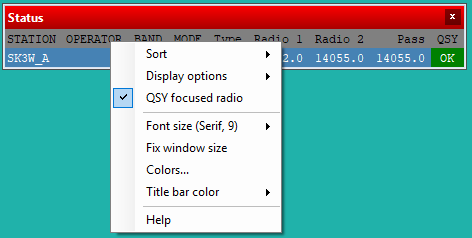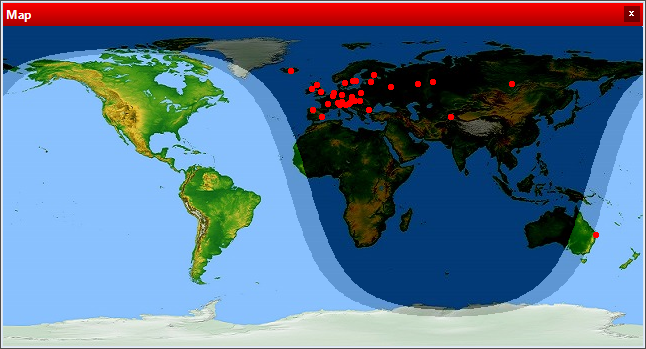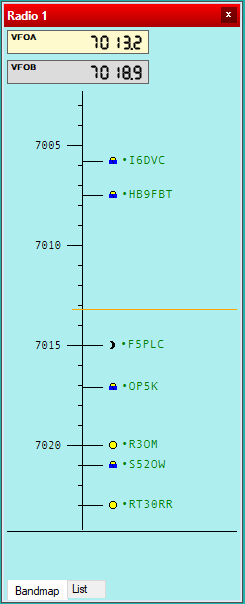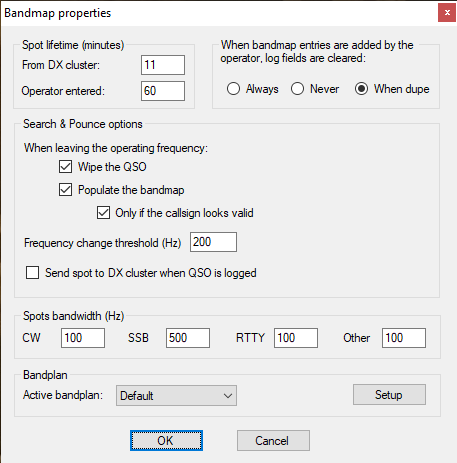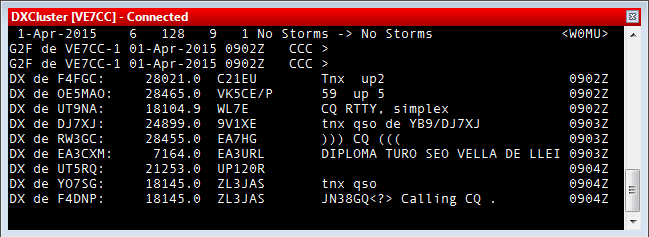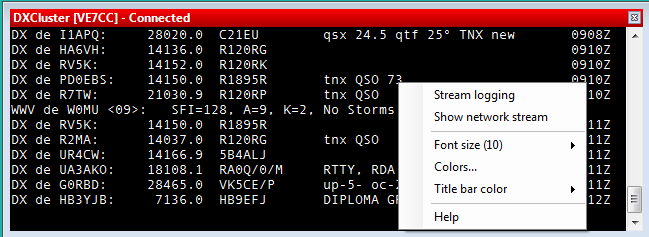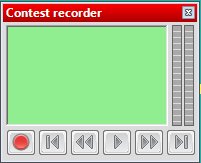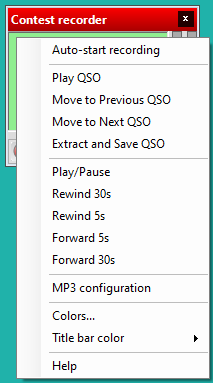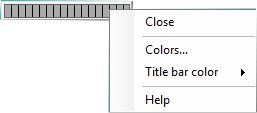Difference between revisions of "Menu Windows"
(→Gab) |
(→Gab) |
||
| Line 36: | Line 36: | ||
A double-click in a station name in this window will open the chat dialog, with this station name as default destination. | A double-click in a station name in this window will open the chat dialog, with this station name as default destination. | ||
| − | To send a message use Shortcut: <b><code>ALT+G</code></b | + | To send a message use Shortcut: <b><code>ALT+G</code></b> and the chat entry window will appear. |
[[image:chat.png]] | [[image:chat.png]] | ||
Revision as of 21:45, 1 April 2015
Menu:Windows
Contents
- 1 Worked DXCC
- 2 Check callsign
- 3 Check multipliers
- 4 Check partials
- 5 Check N+1
- 6 Summary
- 7 Rate
- 8 Operating info
- 9 Statistics
- 10 Gab
- 11 Status window
- 12 Partner
- 13 Radio/Ant status window
- 14 World Map
- 15 Radio 1
- 16 Radio 2
- 17 Primary decoder Radio 1
- 18 Secondary decoder Radio 1
- 19 Primary decoder Radio 2
- 20 Secondary decoder Radio 2
- 21 DX-Cluster monitor
- 22 DX-Cluster announcements
- 23 Clock
- 24 Contest Recorder
- 25 SSB Bargraph
Worked DXCC
Shortcut: ALT+M
Check callsign
Shortcut: F9
Check multipliers
Shortcut: F10
Check partials
Shortcut: F12
Check N+1
Shortcut: F8
Summary
Shortcut: ALT+S
Rate
Shortcut: ALT+R
Operating info
Statistics
Shortcut: CTRL+F9
Gab
Shortcut: ALT+I
Gab window displays all the chat between networked stations. In the context menu, the option "Save history to file" allows all the gab chat to be recorded in the .gab file of the current contest. A double-click in a station name in this window will open the chat dialog, with this station name as default destination.
To send a message use Shortcut: ALT+G and the chat entry window will appear.
Type a message and select either the individual station you wish to message or all to message all networked computers then click ok
Gab window context menu - right mouse click on gab window.
Status window
Shottcut: ALT+J
The status window indicates the status of each station connected to the network. From left to right, are displayed : Station name, Current band and mode, Station type, QSY frequency of the current band and mode, Radio 1 frequency, Radio 2 frequency, Time left before a possible QSY, according to the 10 minutes M/S rule, or "OK" if the station is allowed to make a QSY on another band (only appears if the contest specifies this particular rule). Your own station is displayed in a deep blue background. The active radio of each station has its frequency in red characters. A double left click on a station name will display the chat dialog with this station name as default destination. A double left click on any frequency displayed will tune the current radio to that frequency.
Open the context menu by right mouse clicking in the window
Partner
This feature is especially useful in a Multi-OP environment when facing large pile-ups and/or weak signals.
Set up a second operator as support with a second computer which has DXlog.net installed and a pair of headphones connected to the receiver, on both comptuers open up the Partner window.
The running operator continues as before,working the callsign he hears. The support operator listens at the same time and tries to copy additional callsigns from the pile-up by entering the callsign on the QSO entry field and then pressing Alt-Enter.
This callsign will now be displayed in the Partner Window stack for the running operator to use as his next contact
The Partner window can hold up to 9 callsigns, and theses calls can be pulled into the callsign field with Alt-1, Alt-2 .... Alt-9. Once the QSO is logged, that callsign will disappear from both partner windows.
The Partner can remove a callsign if incorrect or no longer valid using Alt-1, Alt-2 .... Alt-9.
A field in the partner window can be overwritten by a new entry by pressing Ctrl-1, Ctrl-2...Ctrl-9.
Radio/Ant status window
World Map
World map showing Daylight, Greyling and Night.
Options are selectable by right mouse clicking on the map. Grey line display options can be adjusted from this menu.
Map size can be increased by using the zoom in option in the right click menu.
Radio 1
Radio information displaying VFO A and VFO B frequency information.
Single click on VFOA or VFOB to change focus to this VFO.
Band map tab shows radio band in focus and any DX Cluster received or locally entered callsigns plus other optional information.
List tab shows a list of call signs which can be sorted in various ways.
Colours are:- RED = Double Mult, GREEN = Mult, Black = Unworked, GREY = Worked
Information below the horizontal divider is available mult numbers, available QSO's and points available.
Double clicking on a callsign sets the focus radio VFO to that frequency (and in split mode if information available from split DX Cluster spot) and puts the callsign into the log callsign field. This can be changed to a single click by selecting the enable single click selection from the right mouse click menu.
In list mode the data can be sorted in a number of ways from the right mouse click menu and sort
Display options for both Band Map and List mode are set from the right mouse click menu and display options
Various properties can be set from the right mouse click menu and Properties
Bandplan Settings for Bandplan spots to be displayed are set from the right mouse click menu and display options then left click setup in the bandplan section.
Radio 2
Radio 2 is as per Radio 1 but for SO2R mode when 2 radios are connected to the one instance of DXlog.net
Primary decoder Radio 1
Secondary decoder Radio 1
Primary decoder Radio 2
Secondary decoder Radio 2
DX-Cluster monitor
Shortcut: ALT+O
Floating window displaying live information from the connected DXCluster as received.
Right click on the window for options
Stream logging - if checked, will save last 500 lines of DXCluster monitor window to temp file. File will be read on a restart to restore data.
Show network stream - if more than one networked PC is in use, and you run a connection to DXClusters on more than one of the PC's in the network, checking this option will show data from all DXCluster connections in the DXCluster monitor window, but with different color.
DX-Cluster announcements
Shortcut: ALT+A
File:Dx cluster announcments.png
Floating window showing received DX Cluster spots
Double left click mouse on a spot to tune connected radio to this frequency and auto enter the callsign into the log callsign field
Spots displayed can be set manually per band or any number of bands or automatically from the connected radio band data, set using the displayed bands drop down menu from right clicking on the window
Also display multipliers only can be selected from the right click menu
File:Dx cluster announcments rc db.png
Information displayed in the window can be added or removed using the right click menu and selecting display options
File:Dx cluster announcments rc do.png
Incorrect spot callsigns can be modified by right clicking the callsign and selecting modify from the menu
File:Dx cluster announcments rc sm.png
Spots can be deleted by right clicking the callsign and selecting Delete
Clock
Time information bar, including Sunrise and Sunset times and the active station callsign
Drag to move
Right mouse click on bar for options
Contest Recorder
The contest recorder allows you to record both main and sub VFO audio for the whole contest in MP3 format onto your PC hard disc.
If you want to start recording, you have to download libmp3lame.dll [1] and copy it into DXLog.net installation folder. Usually C:\Program Files\DXLog.net. but for newer Windows versions (Vista, Win7), usually C:\Program Files(x86)\DXLog.net.
Before recording, see Options->MP3 config to set parameters which fits to your PC sound card setup.
Encoding rate is currently fixed to 32000 kHz, stereo, 96kbps which is more than adequate for good recordings with a reasonable file size.
Recording levels are set in the Windows Recording Devices of your PC, strongest signals should peak top yellow on the Contest Recorder bar graph display for best results.
Playback using the buttons on the Contest Recorder or right click on the Contest Recorder for more playback options:-
[1] - Link to libmp3lame.dll download
SSB Bargraph
Bargraph showing output of recorded files for Function Keys
Drag to move
Right click for options

